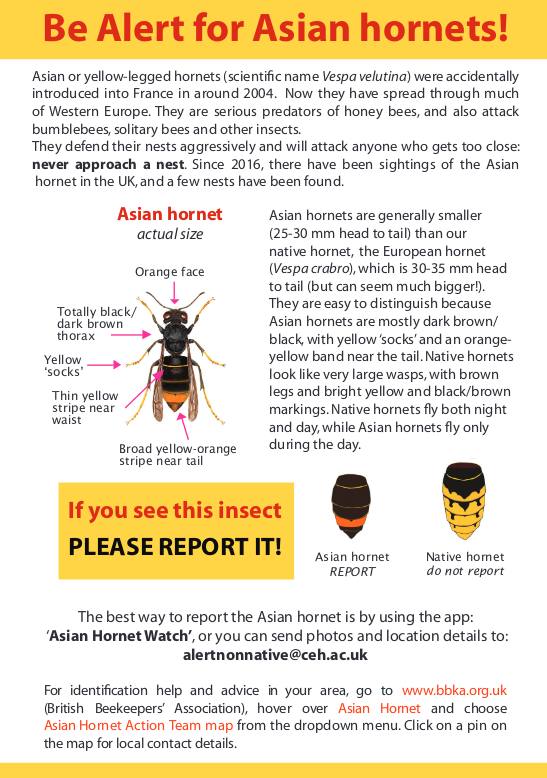Everyone can play a part in keeping an eye out for Asian hornets - no experience is required!
It is a testament to the general public that most of the Asian hornets found on mainland UK since 2016 have been spotted by people going about their daily lives.
How can you help?
When the queen Asian hornets come out of hibernation around March/April they will be looking for high-sugar food sources. The queens can fly very long distances to set up and build their nests. In order to do this they have to feed up on nectar (carbohydrate) for energy and will visit any spring flowering shrubs that have open single flowers and a good nectar supply. Since camellias are native to the Asian hornet's region of origin in south east Asia, it is thought they will seek out these shrubs in preference to anything else.
 By spreading the word to others is a great way to raise awareness. For example, download and print out Asian Hornet information sheets and get involved.
By spreading the word to others is a great way to raise awareness. For example, download and print out Asian Hornet information sheets and get involved.
- Add to notice boards in libraries, GP surgeries, schools, villages halls, golf clubs, allotments, etc in your area
- Ask staff at garden centres, stately homes, botanic gardens, hotels with gardens, country parks to put on boards in public areas
- Give to natural history societies, wildlife trust centres, other conservation charities to raise awareness
- When visiting RSPB venues, other reserves add to any notice boards
- Hand copies to U3A groups, ramblers, orienteering groups, etc.
You can also help by raising awareness with companies and organisations, for example:
- Tree surgeons, garden maintenance companies, plant nurseries
- Farmers and their staff, hedge layers, fruit growers
- Council workers, town parks
- Inland lakes boating clubs, fishing clubs, local water board staff
- Parish newsletters
- Hospital ground staff
- Zoos and animal shelters.
There are also a number of places where an Asian hornet can be brought into the country, for example:
- Food distribution hubs, timber yards
- Travel congregation points - airports, harbours, camp sites
- Wet fish distribution centres - fishing ports, fish shops
Many people are on social media and it's a great way to share with your family and friends how you can get involved.
Are you a beekeeper?
 If you are a beekeeper associated with the British Beekeepers' Association (BBKA) and interested in becoming an AHAT Coordinator for your area, please send an email to the BBKA directly.
If you are a beekeeper associated with the British Beekeepers' Association (BBKA) and interested in becoming an AHAT Coordinator for your area, please send an email to the BBKA directly.
For any BBKA branches or associations who would like to nominate an AHAT Coordinator, please also send an email to the BBKA directly.
Before nominating, please ensure your branch understands the role of the BBKA and beekeepers concerning Asian hornets.
AHAT Coordinators
To find the nearest AHAT Coordinator near you, simply click on the interactive map markers below to find their contact details.
Source: British Beekeepers' Association
Did you know?
Asian hornets can fly at approximately 3 metres per second. In comparison, the normal top speed of a honey bee would be about 21-28 km per hour when flying to a food source and about 17 km per hour when returning lladen down with nectar and pollen.
